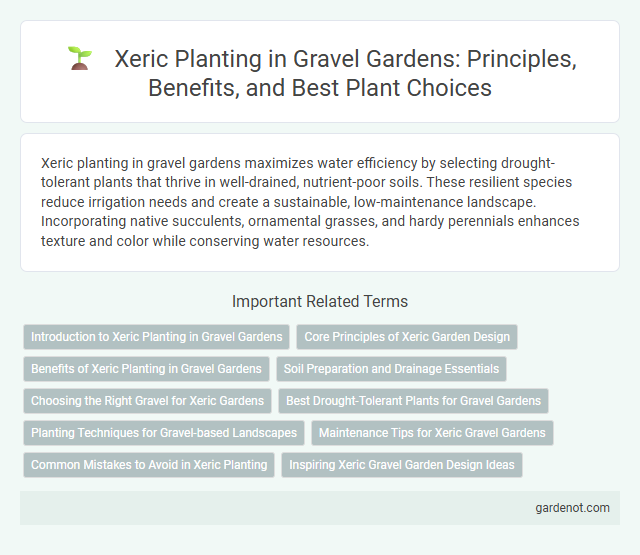Xeric planting in gravel gardens maximizes water efficiency by selecting drought-tolerant plants that thrive in well-drained, nutrient-poor soils. These resilient species reduce irrigation needs and create a sustainable, low-maintenance landscape. Incorporating native succulents, ornamental grasses, and hardy perennials enhances texture and color while conserving water resources.
Introduction to Xeric Planting in Gravel Gardens
Xeric planting in gravel gardens emphasizes the use of drought-tolerant plants adapted to arid conditions, reducing water consumption and maintenance. Succulents, ornamental grasses, and native Mediterranean species thrive in well-drained, nutrient-poor substrates typical of gravel settings. This sustainable landscaping approach enhances biodiversity while creating visually striking, low-water-use garden designs.
Core Principles of Xeric Garden Design
Xeric garden design prioritizes water conservation by selecting drought-tolerant plants such as succulents, ornamental grasses, and native species well-adapted to arid environments. Efficient soil preparation includes enhancing drainage with sandy or gravelly substrates to prevent water retention and root rot. Strategic placement of plants based on sun exposure and microclimates ensures optimal growth while minimizing irrigation needs.
Benefits of Xeric Planting in Gravel Gardens
Xeric planting in gravel gardens conserves water by using drought-tolerant species that thrive with minimal irrigation, reducing maintenance needs and resource consumption. These plants improve soil health by preventing erosion and enhancing drainage within gravel substrates. Xeric planting also supports local biodiversity by providing habitats for pollinators and resilient flora adapted to dry environments.
Soil Preparation and Drainage Essentials
Xeric planting in gravel gardens requires well-drained, sandy or gritty soil with minimal organic matter to prevent water retention. Soil preparation involves loosening compacted ground and incorporating coarse sand or fine gravel to enhance drainage and aeration. Ensuring proper drainage prevents root rot and supports drought-tolerant plants adapted to arid, nutrient-poor conditions.
Choosing the Right Gravel for Xeric Gardens
Selecting the right gravel for xeric gardens involves prioritizing materials that enhance drainage and retain minimal moisture, such as crushed granite or decomposed granite. Opting for light-colored gravels like white marble chips or light quartzite reflects sunlight, helping to regulate soil temperature and reduce water evaporation. Gravel particle size also impacts soil aeration and weed suppression, with 3/8 to 3/4-inch diameter stones offering an optimal balance for xeric planting environments.
Best Drought-Tolerant Plants for Gravel Gardens
Succulents like Sedum and Sempervivum thrive in gravel gardens due to their exceptional drought tolerance and minimal water requirements. Lavender and Russian sage are ideal xeric plants, offering aromatic foliage and vibrant blooms while conserving moisture in arid conditions. Ornamental grasses such as Festuca and Blue Oat Grass provide texture and resilience, making them perfect for sustainable, low-maintenance gravel landscapes.
Planting Techniques for Gravel-based Landscapes
Xeric planting techniques for gravel gardens enhance water conservation and soil aeration by selecting drought-tolerant species such as sedums, lavender, and ornamental grasses that thrive in well-drained, nutrient-poor substrates. Strategic plant spacing and layering create a microclimate that reduces evaporation and supports root development in coarse, gravelly soil. Incorporating organic mulch beneath gravel layers improves moisture retention while maintaining the aesthetic and functional benefits of xeric landscapes.
Maintenance Tips for Xeric Gravel Gardens
Xeric gravel gardens require minimal watering, relying on drought-tolerant plants like sedum, yucca, and lavender to thrive in well-drained soils. Regularly remove weeds to prevent competition for nutrients and maintain clean gravel surfaces for optimal aesthetic appeal. Seasonal pruning of dead or overgrown foliage promotes healthy growth and preserves the garden's structured appearance.
Common Mistakes to Avoid in Xeric Planting
Overwatering and selecting non-drought-tolerant species are common mistakes in xeric planting that can lead to plant stress and failure. Ignoring soil preparation, such as failing to improve drainage with gravel or sand, often results in water retention issues harmful to xeric plants. Poor plant spacing reduces airflow and increases competition for limited resources, undermining the success of a gravel garden designed for drought-resistant vegetation.
Inspiring Xeric Gravel Garden Design Ideas
Xeric gravel garden designs emphasize drought-tolerant plants such as succulents, ornamental grasses, and native wildflowers, creating visually striking landscapes with minimal water usage. Incorporating varied textures and colors from gravel beds, stone pathways, and resilient xerophytes maximizes aesthetic appeal and sustainability in arid environments. Strategic placement of drought-resistant species alongside permeable gravel enhances soil moisture retention and promotes eco-friendly gardening practices.
Xeric planting Infographic

 gardenot.com
gardenot.com